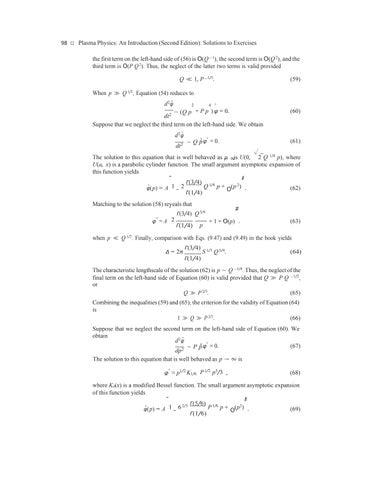98 □ Plasma Physics: An Introduction (Second Edition): Solutions to Exercises the first term on the left-hand side of (56) is O(Q −1), the second term is O(Q 2), and the third term is O(P Q 2). Thus, the neglect of the latter two terms is valid provided Q ≪ 1, P −1/3.
(59)
When p ≫ Q 1/2, Equation (54) reduces to d 2 φ̂
4 ˆ + P p ) φ = 0. − (Q p 2
dt2 Suppose that we neglect the third term on the left-hand side. We obtain d 2 φ̂ dt2
− Q p2 φˆ = 0.
(60)
(61)
√ The solution to this equation that is well behaved as → p ∞is U(0, 2 Q 1/4 p), where U(a, x) is a parabolic cylinder function. The small argument asymptotic expansion of this function yields " # Γ(3/4) 1/4 2 1 2 Q p + (p ) φ̂(p) = A – . (62) O Γ(1/4) Matching to the solution (58) reveals that " # Γ(3/4) Q 5/4 φˆ = A 2 + 1 + O(p) . Γ(1/4) p
(63)
when p ≪ Q 1/2. Finally, comparison with Eqs. (9.47) and (9.49) in the book yields ∆ = 2π
Γ(3/4)
S 1/3 Q 5/4.
(64)
Γ(1/4) The characteristic lengthscale of the solution (62) is p ∼ Q −1/4. Thus, the neglect of the final term on the left-hand side of Equation (60) is valid provided that Q ≫ P Q −1/2, or Q ≫ P 2/3. (65) Combining the inequalities (59) and (65), the criterion for the validity of Equation (64) is 1 ≫ Q ≫ P 2/3. (66) Suppose that we neglect the second term on the left-hand side of Equation (60). We obtain d 2 φ̂ (67) − P p4 φˆ = 0. dp2 The solution to this equation that is well behaved as p → ∞ is φˆ = p1/2 K1/6 P 1/2 p3/3 ,
(68)
where Kν(x) is a modified Bessel function. The small argument asymptotic expansion of this function yields " # 2/3 Γ(5/6) 1/6 2 1 6 P p + (p ) φ̂(p) = A – . (69) O Γ(1/6)

